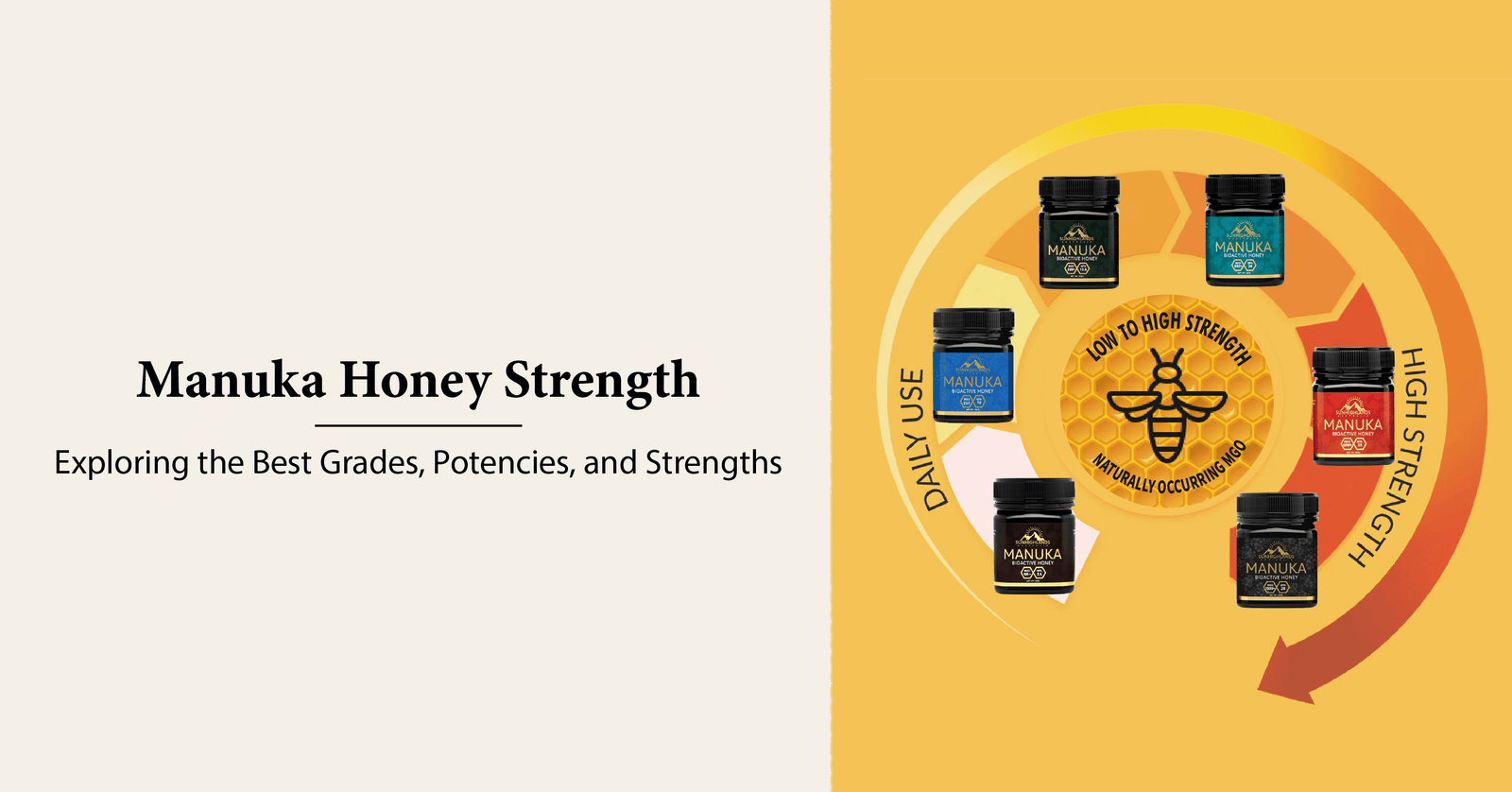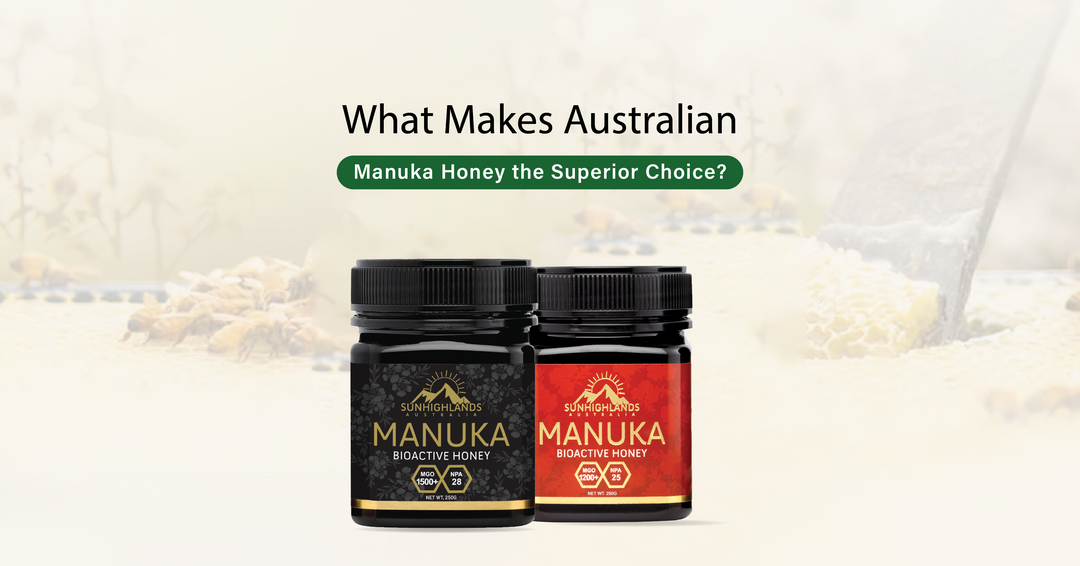Manuka Honey Strength: Exploring the Best Grades, Potencies, and Strengths

Manuka honey, celebrated for its exceptional health benefits and unique properties, has become increasingly popular in recent years. This honey is renowned for its antibacterial and healing properties, making it a prized commodity in natural health products.
Derived from the nectar of the Manuka bush native to Australia, this honey boasts potent antibacterial and healing properties, making it a highly sought-after natural health product. However, navigating the various grades and strengths of Manuka honey can be daunting for consumers.
In this blog, we delve into the intricacies of Manuka honey grading systems, discuss the significance of strength factors, and explore which grades and strengths might be best suited to different needs.
Understanding Manuka Honey Grading Systems
Manuka honey is graded based on several factors, primarily focusing on its purity and the potency of beneficial compounds. The three most recognized grading systems are the Non-Peroxide Activity (NPA), Methylglyoxal (MGO), and Unique Manuka Factor (UMF) ratings.
Non-Peroxide Activity (NPA) Rating
Developed by the Active Manuka Honey Association (AMHA), the NPA rating measures the honey's non-peroxide activity, which indicates its antibacterial strength. This rating is derived from the presence of methylglyoxal and other unique compounds naturally occurring in Manuka honey.
Methylglyoxal (MGO) Rating
Methylglyoxal is one of the key compounds responsible for Manuka honey's unique properties. The MGO rating measures the concentration of methylglyoxal in the honey. A higher MGO rating indicates a higher concentration of methylglyoxal, which is directly linked to the honey's antibacterial strength.
Unique Manuka Factor (UMF)
The UMF grading system certifies Manuka honey's authenticity and assesses the concentration of key chemical markers, including DHA (dihydroxyacetone), Methylglyoxal, and Leptosperin. The UMF rating indicates the level of antibacterial activity and purity of Manuka honey. Higher UMF ratings generally correlate with higher potency and purity.
What is the Best Grade of Manuka Honey?
The best grade of Manuka honey largely depends on its intended use and the desired potency of its health benefits. Here’s a breakdown of commonly available grades and their typical applications:
- NPA 5-10: Entry-level Manuka honey, suitable for general health maintenance and occasional use.
- NPA 10-15: Mid-range potency, ideal for supporting immune function and overall health.
- NPA 15+: High potency honey, recommended for therapeutic use and addressing specific health concerns.
Selecting the best grade involves considering the purpose of use and the desired strength of antibacterial activity.
What Strength of Manuka Honey is Best?
The strength of Manuka honey refers to its antibacterial potency, primarily determined by its NPA, UMF, or MGO rating. The choice of strength depends on the severity of the condition being treated or the intended health benefit. Here’s a detailed look at different strength categories based on NPA:
Low Strength (NPA 5-10)
- Benefits: Suitable for general health maintenance, boosting immunity, and as a natural sweetener.
- Recommended Use: Daily consumption, minor wound care, and as a preventive measure against infections.
Medium Strength (NPA 10-15)
- Benefits: Enhanced antibacterial properties suitable for treating minor wounds, sore throats, and digestive issues.
- Recommended Use: Therapeutic applications, immune support during seasonal changes, and addressing mild bacterial infections.
High Strength (NPA 15+)
- Benefits: Powerful antibacterial and healing properties effective against more severe infections, skin ulcers, and gastrointestinal issues.
- Recommended Use: Intensive therapeutic use under medical guidance, treatment of chronic conditions, and boosting overall immune resilience.
Factors Influencing Manuka Honey Strength
Several factors influence the strength and efficacy of Manuka honey:
- Purity and Authenticity: Genuine Manuka honey sourced from reputable producers ensures higher potency and efficacy.
- Processing Methods: Minimal processing preserves the honey’s natural enzymes and compounds, enhancing its therapeutic benefits.
- Storage Conditions: Proper storage maintains the honey's potency over time, preventing degradation of active compounds.
Making the Right Choice
When selecting Manuka honey, consider the following tips to ensure you get the best quality and potency:
- Check for Certification: Look for NPA, UMF, or MGO certification on the label to verify authenticity and quality.
- Understand Your Needs: Choose a grade and strength that aligns with your health goals and the severity of the condition being addressed.
- Consult a Professional: For therapeutic use or severe health conditions, seek advice from a healthcare provider or a certified naturopathic practitioner.
Conclusion
Manuka honey's strength and efficacy are determined by various grading systems, including the NPA rating, which measures its antibacterial potency. The best grade and strength of Manuka honey depend on individual health needs and intended uses, ranging from general health maintenance to intensive therapeutic applications.
By understanding these factors and making informed choices, consumers can harness the full potential of Manuka honey as a natural health remedy. In a nutshell, whether you're looking to bolster your immune system, treat minor ailments, or address more severe health conditions, Manuka honey has a suitable grade and strength to meet your needs. Embrace the power of this golden elixir responsibly and reap the manifold benefits it offers for your well-being.





